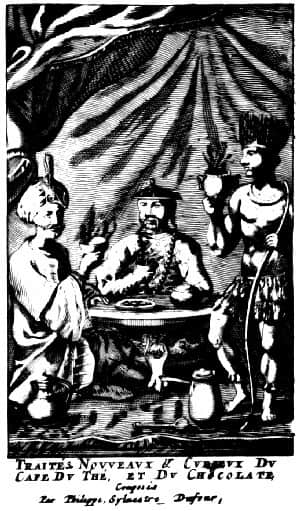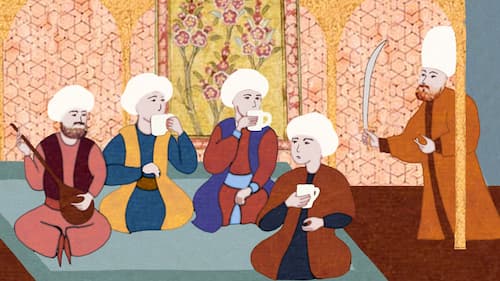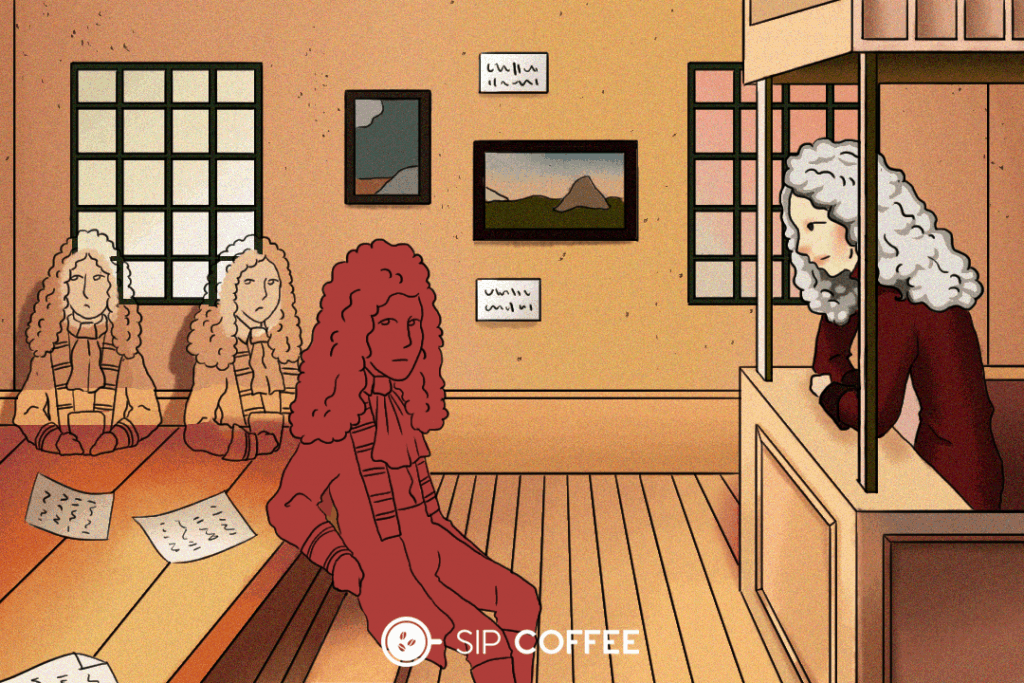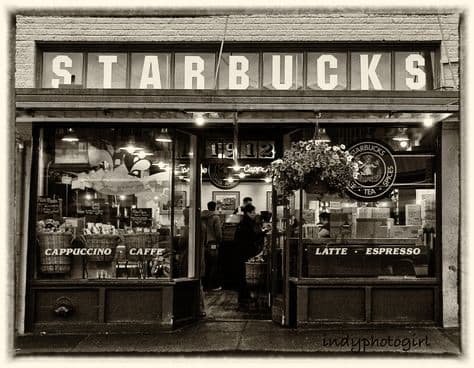The History Of Coffee: Origins And Discovery
The history of coffee is an exciting story that dates back to the 15th century. While today, coffee is sold and is found on pretty much all continents, it wasn’t always this way.
Originating from a small coincidence in Ethiopia to now millions of these magical beans being traded, ground, and brewed across the world.
It’s a story of discovery – including royalty, smuggling, and more!
If you’re anything like me you’ve wondered about where coffee comes from, and if that’s you you’re in the right place… Let’s get started!
Where Did Coffee Originate From?
Abyssinia, now known as Ethiopia, is considered the birthplace of the coffee plant. The story of the origin of coffee is based on an epic tale now considered Ethiopian folklore.
So what’s the story?
How Was Coffee Discovered and First Developed?
Legend has it that in 850 AD a goat herder called Kaldi noticed his goats were excited at all hours of the day and night.
In particular, he realised they were not sleeping well after eating a certain kind of red berries.

This piqued his interest, and he decided to try some berries for himself, being pleasantly surprised by their stimulatory effects.
Thankfully for us, instead of keeping this a secret the goat herder decided to share his findings with nearby monks at a monastery.
Upon arriving at the monastery, an elated Kaldi told the head monk what effects the berries had on him, and to his disappointment the monk immediately disapproved of their use, calling them devils work.
The monk confiscated the berries off Kaldi and threw them into the fire heating the monastery to destroy them.
A disappointed Kaldi looked on, but something magical was about to happen…

The sweet aroma of roasted coffee started to fill the monastery, and other monks approached the fire to find out what was going on.
Intrigued, the monks recovered the beans from the heat, and under the instruction of the head monk crushed and brewed them into a drink.
As they sipped the coffee, they soon felt stimulated and realised it could be a potentially useful tool for them. Helping them stay awake to pray and meditate.
Yemen Became Coffee Gatekeepers
While the story of Kaldi and his goats is not written in stone, one thing is for sure: Coffee beans do originate from Ethiopia.
But, how did coffee become such an abundant commodity with demand spanning the globe?
The journey of coffee globalisation stems back to 1454 where Sheikh Gemaleddin Abou Muhammad Bensaid, the Mufti of Aden (a respected Imam) saw locals drinking coffee and enjoying its effects.
Impressed with the drink, he mobilised a shipment of coffee to cross the Red Sea into Yemen, via a port called Al-Makkha otherwise known as Mocha (That’s where the word comes from!).
It was Mocha which held a coffee monopoly controlling the supply of coffee to other regions in the world for centuries. If anyone wanted coffee, they had to go to Mocha to buy it and then smuggle it to wherever they wanted to sell it!
Coffee Houses Were Schools Of The Wise
Soon, the Yemeni were growing their own coffee and supplying the growing demand.
Which subsequently pushed it further inland soon reaching Egypt, Persia, Turkey and eventually Mecca, (Saudi) Arabia.
Public coffee houses known as Kaveh Kanes started popping up all across Arabia. Originally religious meeting places, they quickly became popular for all walks of society and used as a place where people met up to chat and hear gossip.
Coffee houses became known as the schools of the wise, the places where information flowed freely, and the chatter didn’t stop.

However, as interest in the beverage started to spread so did concerns from mullahs around its use over religious grounds.
As a result, because coffee had a stimulating effect, a court in Mecca issued a decree and shut down the coffee houses in the 1500s.
Still, nothing could stop the mass interest and demand for coffee.
These bans were quickly lifted in the end, and the beans ended up all over the Middle East through various smuggling routes making coffee history.
Coffee Enters Europe and Asia
While coffee was relatively popular before marching into Europe and Asia, demand skyrocketed when it entered Southern Europe and South East Asia.
Off With The Head
By the early 16th century Salim I had conquered Egypt and as a result smuggled coffee had reached Constantinople; with coffee houses opening shortly thereafter.
Again met by a similar mistrust of the coffee bean, Sultan Murad IV, the ruler of the Ottoman Empire made drinking the hot beverage a capital offence.

His form of punishment was probably the most brutal, disguising himself as a commoner he would walk around Istanbul decapitating anyone he saw drinking coffee!
Asia and Beyond
Later, In the 17th century, fertile coffee husks were taken by Baba Budan (a Sufi saint) on his return from pilgrimage in Mecca to South West India.
Laying the groundworks for what today is still a region for mass coffee cultivation.
Dutch traders smuggled out coffee seedlings from Yemen and took them to Java. By the early 18th century the Dutch colonialists launched plantations all around Java, and soon enough coffee spread all over the island nation.
Setting the scene for what is now known as one of the largest coffee-growing hubs in the world.
Coffee Conquers Europe
Around the same time, Venetian merchants introduced coffee to Europe, and it quickly became a popular beverage.
But the church raised similar to concerns as the mullahs in Mecca, dubbing the beverage as a product of Satan.
That was until Pope Clement VIII tasted it and classed it a Christian beverage by baptising it!

Coffee houses began to appear all across Europe, spurred on by mass adoption as hubs buzzing with social activity similar to as in Arabia.
The first coffee house in England opened in Oxford in 1652. Others began in London and other cities around the same time.
Coffee houses quickly became popular in England as unlike public houses (known as pubs in England) where alcohol was served. A coffee house was a dry establishment and women were barred.

Sparking polite and intelligent debate, they were nicknamed penny universities, on the basis that knowledge could be gained at the price of a cup of coffee.
Interestingly, several British institutions can trace their history back to a coffee house, from the London Stock Exchange to Loyd’s of London.
Later, In 1669 Paris was introduced to coffee via the ambassador to Turkey.
Paris’s first coffee house opened in 1686 and expanded into other cities across the country shortly after that as its popularity as a place for socialization grew.
How was Coffee Introduced To The Americas?
The global domination of these small beans had one final frontier left in their journey to worldwide stardom…The Americas…So how did they do it?
Well, they had to cross the Atlantic Sea first…
The Caribbean and Caffeine
The Dutch had access to coffee through their colonial roots in Indonesia.
But, it wasn’t until 1714 when the Mayor of Amsterdam gave the then King Louis XIV of France a clone of a coffee plant.
Eager to enter the trade, he planted the young tree in the Royal Garden in Paris. Shortly there after, the French tried to grow coffee on the island of Réunion in the Caribbean, but failed miserably.
In 1723, a French naval officer by the name of Gabriel Mathieu de Clieu decided he was going to grow coffee on his estate in Martinique, but he needed a coffee clone to be successful.
He took clippings of the tree growing in the Royal Garden and took it to the Caribbean.
According to his journal, Gabriel was up against difficult weather and found It hard to keep the cutting alive. He gave the plant water from his rations to keep it from wilting away.
Thankfully, his devotion led him to success, and within a few years, products of his seedling were found all around the Caribbean.
Even more so, according to The Book of Coffee “From this single plant, Martinique supplied seed directly or indirectly to all the countries of the Americas except Brazil, French Guiana and Suriname”.
From there on in Gabriel had pencilled his name into the history of coffee records!
The Coffee Gods Of Brazil
Brazil is the worlds largest producer of coffee today, but how did they first get started?
Brazils coffee history can be mostly attributed to a small territory dispute between French Guiana and Suriname. Being unable to come to a resolution, they asked Brazil to mediate the discussions.
An army officer called Francisco de Melo Palheta was sent under the guise of resolving the problem, but his priority was to bring back plants for coffee cultivation!

Palheta settled the dispute and was given a banquet as a farewell gift from the governor, looking Inside he noticed there were no coffee seeds to take back.
But low and behold, he was also given a bouquet by the governors’ wife and hidden beside the flowers were coffee seeds.
Palheta took those seeds and grew them into a business which now constitutes a coffee empire!
The Boston Tea Party
While there are records in history of Dorothy Jones obtaining the first US licence to sell coffee in the late 17th century, it wasn’t until the century after when coffee really took off in the United States.
Why?
Taxation.
The British had introduced the tea act in 1773, which added heavy levies on tea which at the time was the most popular hot beverage, and was being imported to the United States.
As a protest, a large group of men disguised as Native Americans, sneakily boarded English tea ships docked in Boston and threw 342 chests of tea overboard…At an estimated cost of $1,000,000!
It took more than three hours to dump the tea, and they managed to throw over 45 tons of the stuff into the sea!
In a direct effort to remain patriotic, a mass revolt against Englands King George III sparked a switch from tea consumption to coffee.
Since that day, coffee consumption has grown in the United States, and the country now imports more coffee beans than any other nation and also grows some coffee plants of their own too!
The Coffee Industry Continues To Grow
Coffee proliferated most countries by the late 19th century and had now become commonplace.
Still, while coffee was now available nearly everywhere, the techniques around brewing still had some work to do.
Coffee in the 19th century wasn’t fancy, and as a result, there has been a lot of innovation around roasting, brewing and drinking coffee since then.
The modern techniques we take for granted, such as the creation of an espresso shot are only as recent as the 20th century.
Which leads us on to the modern wave of coffee which exists across America today:
US Coffee Revolution
If you’re American, I am sure you have heard of Peet’s coffee shop, right?
But did you know the founder was a Dutch/American gentleman called Alfred Peet?
Peets father roasted coffee back in the Netherlands, and he took inspiration from his father to roast his own coffee in the States.
He launched his first coffee shop in Berkley, California in 1966.
Five years later, his coffee shop was a success.
Inspired by Peet, his friends learnt about coffee by working with him and with his blessing opened up a coffee shop in Seattle called…Starbucks!

I’ve actually been to the starbucks above and it hasn’t changed much! Exact same size and location on pike place market too!
Howard Schultz Changed The Coffee Game
The three friends sold roasted beans out of Starbucks but didn’t sell cups of coffee…yet!
Within 11 years, they had more than 80 employees and 5 retail stores selling coffee beans.
It was in 1981 that Howard Schultz tried a can of supermarket coffee and felt the raw ingredient had high potential.
On his pursuit of learning more, he joined Starbucks in 1982 as the director of operations and marketing.
Schultz had recently visited Italy and noticed the popularity of espresso bars, where people would relax and socialise, with similarities to historical Arabia.
He decided the best thing to do was to copy this Italian phenomenon and Americanise it.
His bosses declined his request to start to selling people a cup of coffee. Schultz decided to double down and left Starbucks to create his own company Il Giornale selling hot drinks.
Il Giornale acquired Starbucks three years later for $3.8 million! From there he had the infrastructure to both roast the beans and then sold coffee by the cup for the highest profit.
This was the beginning of a new era, and Starbucks began its expansion as the Coffee Mecca of the United States.
Regardless of how you feel about the coffee at Starbucks, you have to admire the guts Schultz had and the fact this brought the next wave of this magical elixir to our doorstep.
Final Word
Nowadays, you can’t turn a block in a major city like New York without coming across coffee, and this history has something to do with the obsession the world has around his hot drink!
While the coffee origins are always up for dispute, I hope this article has provided some insight into the madness of the history behind the coffee plant!

